
PREV ARTICLE
NEXT ARTICLE
FULL ISSUE
PREV FULL ISSUE
SELECTIONS FROM HERITAGE APRIL 2020 SALESHere are some lots that caught my eye in the upcoming Heritage April 2020 sales. -Editor Lot 30410: Haiti Henri Christophe 15 Sols Silver Pattern
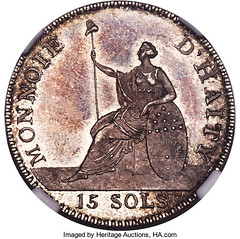 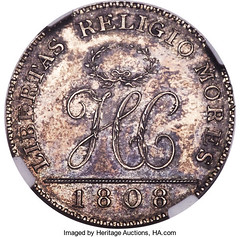 Northern Haiti. Henri Christophe silver Pattern 15 Sols 1808 MS63 NGC, Birmingham mint, KM-Pn7, Fonrobert-7488. A choice example of this scarce issue decorated in delicate silver tones over flashy fields, enhancing the presentation of sharp devices rendered to pinpoint accuracy. Commissioned by Henri Christophe in England as part of the project to improve the crude issues of the State of Haiti struck in Cap Haitien. Commercial agent of Henri Christophe, Jean Gabriel Peltier, contacted Matthew Boulton on January 25, 1808, to manufacture dies for three denominations, 30, 15 and 7.5 sols, equivalent to the English 1 shilling, sixpence and threepence. The dies, while differing from the original sketches furnished by Peltier, which stipulated an obverse with a four-line inscription "ETAT - d'HAITY - PIECE DE - 30 SOLS" encircled in a laurel wreath, were skillfully made, as evidenced by the present specimen. They were manufactured at a cost of 105 guineas and delivered to Peltier by John Woodward (agent of Boulton, Watt & Co. in London) on August 3, 1808, together with various Proof sets: 3 triple sets (3 coins per denomination) and 3 normal Proof sets (1 coin per denomination). Together with some pieces undoubtedly kept by Boulton himself (note that many of the few surviving specimens have surfaced in the UK), the former sets account for the scant surviving examples of these charming patterns. To read the complete lot description, see:
Lot 31036: Constantine the Great Gold Medallion
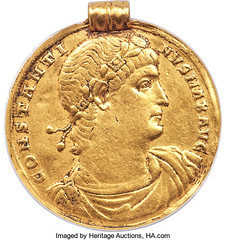 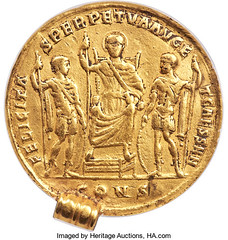 Constantine I the Great (AD 307-337). AV medallion of 9 solidi (47mm, 41.88 gm, 5h). NGC Choice VF 5/5 - 2/5, Fine Style, mount. Constantinople, ca. AD 330. CONSTANTI-NVS MAX AVG, laurel and rosette diademed, draped and cuirassed bust of Constantine I right, seen from front / FELICITA-S PERPETVA AVG E-T CAESS NN, Constantine I, nimbate, enthroned facing, scepter in right hand, mappa in left, flanked by Constantine II and Constantius II, both standing facing in military dress and turned to center, spear in outer hand, inner hand resting on grounded shield; CONS in exergue. RIC VII -. Cohen -. Depeyrot -. cf. Toynbee, p. 198 n. 45; pl. XXXIX, 1 [Constantine II, Constantinople]. cf. Gnecchi p. 16, 11, Nicomedia = Babelon, Revue Numismatique, 1906, "La trouvaille de Helleville (1780)", p. 167, pl. VII, 2 = Babelon, La Trouvaille Monétaire de Helleville (Manche) En 1780, 1910, pp. 16-17, pl. 1, 2 = Toynbee, Roman Medallions, Numismatic Studies 5, p. 62, n. 36, pl. V, 5 = RIC VII Nicomedia 173. An impressive medallion with contemporary intact mount, likely unique. Gold medallions were gifts produced for the emperor to bestow upon high ranking civilian and military individuals, as well as "foreign ambassadors and chieftains whom it was intended to impress." They were "the imperial counterpart of private gifts presented to friends on important occasions." Described by Toynbee as money medallions because they were "true multiples of gold and silver coins" and could therefore legally used as money, they ranged in size from "the 1 ½-solidi pieces first issued by Constantine I to the 72-solidi piece of Valens." An important piece. -Editor To read the complete lot description, see:
Lot 31040: Philippicus Solidus
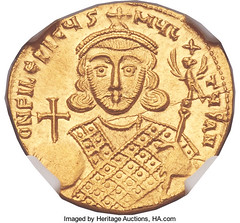 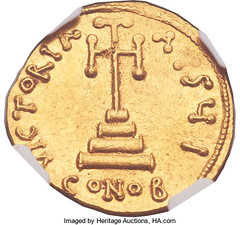 Philippicus (Bardanes) (AD 711-713). AV solidus (20mm, 4.44 gm, 5h). NGC Gem MS? 5/5 - 5/5. Constantinople, 10th officina. d N FIL?PIC?S-M?L-T?S AN, bust of Philippicus facing, wearing crown and loros, globus cruciger in right hand, scepter surmounted by eagle and star in left / VICTORIA-AVS? I, cross potent set upon three steps; CONOB below. Sear 1447. DOC 1. MIB 1. Rare! Minor obverse die break, otherwise an absolutely perfect specimen, crisply struck from fresh dies and fully lustrous. Quite likely the finest-known example! Ex Lexington Collection of Jonathan K. Kern (Heritage Auction, NYINC 3037, 4 January 2015), lot 30988 Part of a debilitating string of short-lived rulers, Bardanes was a general of Armenian origins who was proclaimed Emperor upon the final overthrow of Justinian II. Almost immediately, he alienated the clergy and populace by reviving the Monothelete heresy (proposing that Christ had a single, divine nature and will) which had supposedly been stamped out decades previously. He was also unsuccessful in stopping Arab and Bulgarian advances, prompting the Byzantine army to depose and blind him after 18 months of ineffective rule. He was replaced by the finance minister Artemius, who reigned as Anastasius II. This extraordinary piece shows the unusually fine artistry employed on the coinage for so ephemeral a reign, showing the emperor holding two symbols of office dating back to Roman times: The globus cruciger and scipio aquila, a scepter topped by an eagle. The grade of Gem MS? is the highest possible grade assigned by NGC to an ancient coin. Beautiful, high-grade piece. -Editor To read the complete lot description, see:
Lot 31075: Elizabeth I Gold Ship Ryal
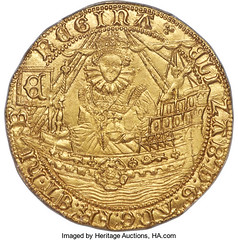  Elizabeth I (1558-1603) gold "Ship" Ryal of 15 Shillings ND (1584-1586) MS64 PCGS, Tower mint, Escallop mm, Sixth issue, S-2530, N-2004, cf. Schneider-785. 7.77gm. Absolutely spectacular, a piece whose very survival seems miraculous; one of the rarest and most popular coins of Elizabeth I's reign, absent from most British collections in any condition, yet preserved here to an unprecedented standard. Every collector of hammered British gold will be familiar with this intensely sought-after issue, designed with charming medieval style imagery and Lombardic lettering. The Ryal was always a slightly controversial type, representing an attempt during Edward IV's first reign to simplify the confusion of circulating gold denominations by producing the equivalent of a 'Half Sovereign' worth 10 Shillings. However, as the Noble of 6 Shillings 8 Pence was by then the accepted standard, the Ryal was ultimately unsuccessful and replaced shortly afterwards by the famous Angel. Despite its initial unpopularity, the 10 Shilling Ryal reared its head once again in Henry VII's reign, and again in Mary's reign (then worth 15 Shillings to match the 30 Shilling Sovereign). By the time of Elizabeth's reign it was a far from necessary denomination and was produced solely for trade in the Netherlands, in a failed attempt to extract profit from the arbitrarily higher price Ryals traded for in the Low Countries. To read the complete lot description, see:
Lot 31076: Charles I Gold Triple Unite
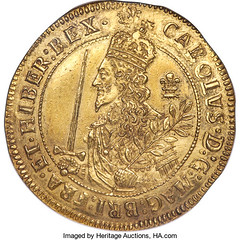 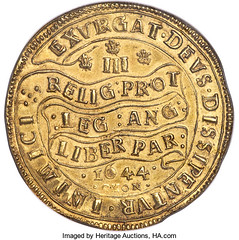 Charles I gold Triple Unite 1644 MS62+ NGC, Oxford mint, Plume mm, S-2729, N-2385, Brooker-841 (same dies). 27.00gm. Of utmost desirability and rarity, one of the finest extant examples of England's largest hammered gold coin produced in the early stages of the English Civil War of 1642-49. Highly sought after in any grade, the present piece represents the single second-from-highest graded example by NGC or PCGS, and combines this exalted preservation with undeniable medallic skill and fascinating numismatic history. Prior to the war, Charles's coinage was almost uniformly poorly-struck, irregular-flanned and as crude as the contemporary Spanish 'pieces of eight'. Certainly, some experiments into milled coinage were being undertaken by Nicholas Briot, but in general Charles's coinage represents a very weak era for the output of the Royal Mint. However - this all changed once Charles left London and hostilities gradually began to take shape. Whilst numerous cities and towns began to declare their loyalty for either Royalists or Parliament, both sides proceeded to mint their own coins so as not to lose grasp of circulating currency and thus risk a breakdown of order. Indeed, coinage underpinned civilization to such an extent that even besieged castles and strongholds resorted to creating their own coins from salvaged plate silver. Parliament's coins were largely similar to the pre-existing regal issue, crudely struck and irregular. Charles, meanwhile, decided that coins were a perfect means of spreading his message and demonstrating his value - and thus he went on to produce exceptionally fine, large-sized pieces of gold and silver bearing his 'Wellington Declaration', stating to his people and Parliament that despite all appearances he upheld "the Protestant religion, the laws of England and the Liberty of Parliament". Of all Charles's 'Declaration' coins, none are so impressive nor celebrated as the Triple Unite represented here in incredible Mint State. Many die varieties exist for this denomination, some rarer than others, but the present piece exhibits what is perhaps the most appealing and high-quality depiction of Charles; bearing a sword in his right hand and an olive branch in his left, the King holds both war and peace in his hands. Close inspection of the surfaces show a concerted effort for high-quality production, numerous die-polish lines yet no rust, evidence for a triple strike in the legends to fully render the intricately engraved devices. Deeply toned to a buttery aged-gold hue, faint sparkles of luster dancing under a mist of patina, every element of the strike crisp and presentable. The J. G. Brooker plate example of this same die pairing was offered in our August 2015 sale; graded AU58, that specimen realized $250,000. We are proud to host this far finer specimen, and do not doubt that is beauty, rarity and supreme quality will earn it a place in a world class collection of British gold. Rare and always popular. -Editor To read the complete lot description, see:
Lot 31108: Grenada gold Counterstamped 66 Shillings
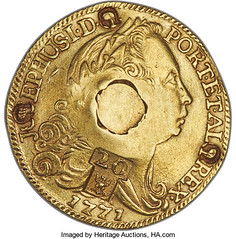  British Colony gold Counterstamped 66 Shillings ND (1798) VF, cf. KM2 (Rare; with stamped plug), Prid-19 (this coin), cf. Gordon-107. 30mm. 11.60gm. Struck over a contemporary counterfeit Brazil Jose I gold 6400 Reis 1771-R (cf. KM172.2 for official issue). Countermarks and host extremely fine. An intriguing piece, apparently double-regulated, first by the island of Grenada and later by the island of Martinique. Following the proclamation by the President of Grenada on 31 July, 1798, Brazilian and Portuguese 6400 Reis (both authentic and forged) weighing at least 9.33gm were plugged with gold in order to raise their weight to a legal specification of 11.66gm so that they could legally pass as 66 Shillings. A margin of error among goldsmiths gave rise to slight variances, though this example is remarkably close to the mandated weight. The plug was then countermarked with the goldsmith's script initials: "IW," "WS," or "JR." Three incuse "G" countermarks were also spaced along the perimeters to prevent clipping, which may be observed on the present example. However, this particular piece is the only known specimen that lacks a countermark on the plug itself. The addition of a second countermark below the central plug, that of an eagle below the numeral "20", all within a T-shaped indent, would indicate a later counterstamp under the authority of Martinique, following the regulation of 26 September, 1805 valuing these pieces at 22 Livres (cf. KM35). The relative dating of the the different countermarks is further supported by, upon close inspection, the very slightly finer state of preservation of this countermark in comparison to that of the Grenada countermarks and of the host. Fascinating piece. -Editor To read the complete lot description, see:
 Wayne Homren, Editor The Numismatic Bibliomania Society is a non-profit organization promoting numismatic literature. See our web site at coinbooks.org. To submit items for publication in The E-Sylum, write to the Editor at this address: whomren@gmail.com To subscribe go to: https://my.binhost.com/lists/listinfo/esylum All Rights Reserved. NBS Home Page Contact the NBS webmaster 
|